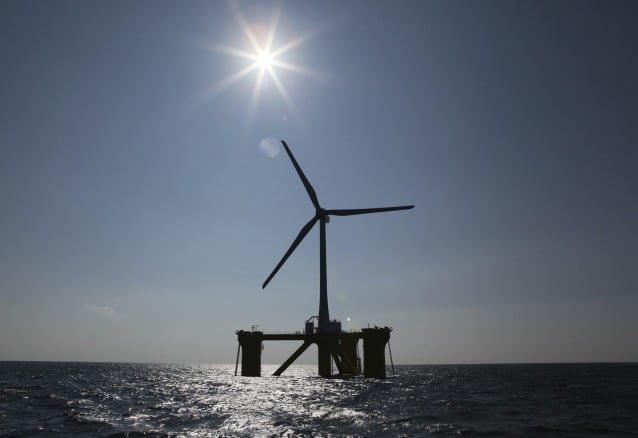
The March 2011 earthquake and tsunami that devastated Japan left a lasting impression on the country’s energy infrastructure and long-term energy vision. The ensuing nuclear meltdown at the Fukushima Nuclear Power Plant put citizens on edge and the nuclear industry — on which leaders had been relying to achieve ambitious clean energy goals — in the cross hairs.
After the disaster, the country halted its nuclear program and all 48 nuclear reactors have been dormant since. As the government attempts to sway public opinion back in favor of nuclear power, reconstitute the nuclear regulatory and oversight program, and get at least some plants online by the end of 2015, an energy swell has been building off Japan’s coast.
While the belt of solar panels around the moon proposed by a Japanese engineering company may never get built, a number of future-thinking offshore power sources are already in the works. Offshore wind is a top priority, with Toshimitsu Motegi, a member of Japan’s ruling Liberal Democratic Party and the former minister of economy, trade and industry, telling Bloomberg this week that Japan is “now focusing on mainly floating offshore wind, but we want to push various types of technical development and research.”
In early September, Japanese electronics and ceramics manufacturer Kyocera announced it was beginning work on what will be the world’s largest floating solar installation. Comprised of two large, floating solar arrays, the 2.9 megwatt project is the first part of Kyocera’s plan to develop around 30 floating two-megawatt power plants, capable of generating a combined 60 megawatts of power.
Solar power installations have taken off across Japan in the last few years, in large part driven by government incentives in the wake of the Fukushima disaster, and acquiring large swaths of land for utility-scale solar is especially daunting in the face of such stiff competition. Japan will have 100 gigawatts of solar power generation capacity by 2030 according to recent estimates, and floating outlets could play a significant role in this rapid growth.
Other buoyant developments include proposed floating natural-gas fired power plants and even offshore nuclear — both of which would provide a safety buffer against future natural disasters that rumble the earth or pummel the coast. But Japan is also a narrow, mountainous country and siting renewable energy projects on land is exceptionally challenging while the ocean is vast and open.
In June, Japan unveiled the first offshore floating wind turbine in Asia. Ten private-sector companies and the University of Tokyo are part of the experimental project commissioned by the Ministry for Economy, Trade and Industry. The world’s first floating power substation was installed a mile away from the two-megawatt turbine, according to the Global Wind Energy Council. About another 350 megawatts of commercial offshore wind projects are in development in the country.
“Offshore wind is one of the best renewable energy resources that Japan has,” Alla Weinstein, CEO of Principle Power, maker of the WindFloat, a semi-submersible floating platform, said recently. “If you look at the natural resources that Japan has; it doesn’t have a lot to choose from.”
Japan has no domestic fossil fuel reserves, and importing fuel has a number of downsides, including cost. Prime Minister Shinzo Abe’s Cabinet has set a target of making floating offshore wind technology viable by 2018.
“In the waters off Fukushima, a power-generating technology of the future is now on the verge of blooming,” Abe said last year. “That is technology for floating offshore wind power.”
On Tuesday, Bloomberg reported that Sevan Marine, a Norwegian company that builds offshore oil-drilling equipment, has proposed building a floating natural gas power plant off the coast of Japan. The 700 megwatt, $1.5 billion project would float atop a cylindrical platform bigger than a football field. It would burn liquefied natural gas.
“The power situation in Japan after the Fukushima disaster has encouraged us to propose this solution,” Fredrik Major, Sevan’s chief business development officer, told Bloomberg.
Offshore nuclear power generation has also been proposed as an alternative power supply. While Japan has not pursued this option yet, Russia is working on a vessel, the Akademik Lomonosov, that will house two nuclear reactors.
These many innovative energy options may offer various clean energy and public safety benefits, but costs are often high and deployment drawn out. One of the most effective means of maintaining a reliable energy supply is electricity conservation and efficiency. After the Fukushima incident, Japan showed surprising adaptability to the sudden reduced power availability. Earlier this year researchers found that Japan managed to replace half its missing nuclear power capacity through enduring energy efficiency and conservation measures.
Source: Climate Progress. Reproduced with permission.










